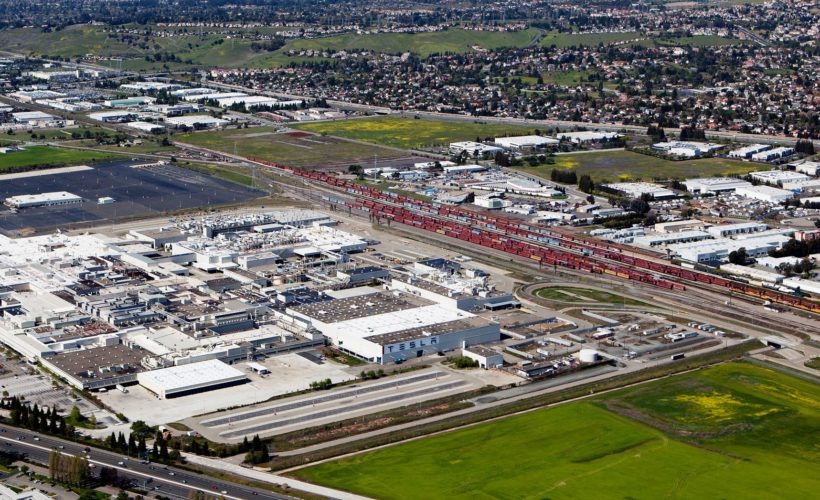Tesla is in a pinch. It’s supposed to be producing lots of cars. Model 3 sedans, specifically. At least 5,000 a week, and, ideally, making money while doing it. But nearly a year after starting production of the car, it has yet to meet that goal, which CEO Elon Musk originally said Tesla would hit before the end of 2017. Now, the second quarter of 2018 is winding down and investors are asking questions: The need to crank out more cars has gotten even more dire.
So in the past month, Tesla did what it has always done, whether in a pinch or not—it got flexible. To augment the two Model 3 assembly lines already running inside his at-capacity factory in Fremont, California, Musk set up a third line. In a big white tent. In the factory parking lot.
“Needed another general assembly line to reach 5k/week Model 3 production. A new building was impossible, so we built a giant tent in 2 weeks,” he Tweeted last weekend. “They also poured the concrete & built the whole assembly line using scrap we had in warehouses. And it’s way better than the other GA [general assembly] line that cost hundreds of millions!”
Musk didn’t say how many cars are being built in the tent, how that work differs from the assembly inside the factory, or what makes this setup any better. But an inspection of the building permits Tesla filed with the City of Fremont yields a better picture of what’s going on in there.
First off, “giant” is a fair descriptor. Nearly 1,000 feet long, 150 feet wide, and 53 feet tall, the tent covers 137,250 square feet. That’s enough to fit two and a half football fields, 122 Model 3 sedans, or, an assembly line. Maybe even two, says Abhay Vadhavkar, who spent the first few decades of his career in manufacturing at Ford and GM, and is now the director of manufacturing, engineering, and technology at the Center for Automotive Research. The tent sits on the northeastern bit of the Fremont property, by the paint shop. It has access to four bathrooms and about 30 fire extinguishers. It’s the third such structure Tesla ordered from San Francisco-based Sprung Structures, and its official name is Sprung 3.
Though the big tent is classified under California’s building code as a “repair garage,” Tesla says it’s most definitely an assembly line, where the major pieces of the vehicles come together. The first parts of the process, where the parts are stamped and the core of the car comes together, still happen inside the factory. Once the parts have been to the paint shop, they come here for final assembly.
Instead of the floor-mounted, arm-like robots working in most plants, the tent is filled with gantries. Think of these like a series of gates, through which the car-carrying conveyor belt runs. They’re not robots, but lift assists—devices that make it easy for human workers to move big hunks of metal. They’re mostly used for “cross car” installations, putting together things that run the width of the vehicle, since that’s work more easily done from above than from the side.
Inside the tent, that series of gantries installs various bits: The IP gantry puts in the instrument panels. The glazing gantry does the windshields and rear glass. You can guess what the “door on gantry” and “seat gantry” do. Something called the “marriage gantry” joins the underbody of the car (where you’ll find the battery, suspension, and motors) to the top bit. The “wheel jib crane” presumably puts on the wheels. At the end of the line, the car rolls down a ramp, back to ground level.
Tesla may be the only automaker that would consider throwing together such a setup in so little time (a City official says Tesla notified it of the project in late May, filed its permits on June 11, and was up and running about a week after that). But bonus assembly lines are an established, if uncommon, way for car makers to do one of two things: make fixes to vehicles that have gone through the regular assembly process, or build vehicles that come with special features, which are hard to integrate into an existing line.
It’s true that Tesla has had quality control issues, but a spokesperson says Elon didn’t pitch the tent to fix up cars. So the second use case makes more sense, given that at least one car that rolled off the new line was the first Model 3 with a dual motor setup. The second motor enables all-wheel drive, drops the car’s 0-60 mph time to 4.5 seconds, and bumps its price up $5,000. It complicates an assembly line, however, to have some cars get two motors, and others get one, which is why Tesla didn’t let customers order that option until a month ago. Just about when it would have started work on the tent. A Tesla rep says the line can also build cars with the single motor setup.
“I think it’s kind of clever and ingenious that they’ve come up with a structure they can put up very very quickly,” says Vadhavkar. And if this is the move that finally puts Tesla across that near-mythical 5,000-car-per-week mark, maybe Musk should consider setting up Sprung 4—and using it for a whopping big party.
More Great WIRED Stories
- Inside the crypto world’s biggest scandal
- Finally, a real world grading system for autopilot tech
- How a $40 million nutrition science crusade fell apart
- Star Wars and the battle of ever-more-toxic fan culture
- Meet Germán Garmendia, the aggressively normal YouTube superstar who wants it all
- Looking for more? Sign up for our daily newsletter and never miss our latest and greatest stories
Source:WIRED












